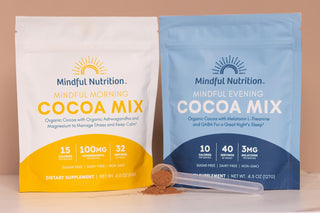Did you know that for at least 80% of hot chocolate's history, it was drunk as a cold, bitter, foamy concoction? Read on for the 2,500-year-long history of hot chocolate, from the ancient Mayans' drink of the gods to the functional beverages of modernity.
Key Takeaways
- The Mayans were drinking chocolate over 2,500 years ago, but humans might have started drinking chocolate even sooner than that.
- The Spanish began transporting chocolate back to Europe in the 16th century.
- Over the centuries, people adjusted the recipe, adding and removing spices and other ingredients like sugar and milk.
- In the 1950s, the first instant hot chocolate mix was invented.
- Even more recently, functional hot chocolates have entered the scene, combining the superfood cacao with other potent ingredients.
See Related: How to Heat Milk For Hot Chocolate in the Microwave
Who Invented Hot Chocolate?
Today, hot chocolate is a sweet treat with a rich taste enjoyed by millions around the world. In the US, hot cocoa is the most popular holiday beverage. A whopping 91% of Americans say they like or love it.
And almost two-thirds of Americans enjoy their hot chocolate made the "traditional" way: cocoa powder, milk, and a topping of marshmallows.
In fact, that method is far from traditional, at least in the context of hot chocolate's long history. For the vast majority of that history, this famous drink was enjoyed by only a few, and in very different ways.
Ways you might not even recognize as the delicious, easy-to-make, sweet hot chocolate we all enjoy today.

Hot Cocoa's Ancient Origins
The very first person to ever taste hot chocolate is almost certainly lost to time. Researchers have uncovered evidence that people in what is now Central America were enjoying chocolate at least 2,600 years ago.
But humans may have discovered the wonders of chocolate even earlier than that.
Now, we say “wonders”. But the chocolate drink enjoyed by the ancient Mayans was very, very different from the hot chocolate of the present day.
According to the accounts of European explorers, the Mayans would grind up cacao beans and mix them with water and other spices. The chocolate drink would then be poured between two cups until a thick foam developed.
The Aztecs then copied this drink from the Mayans. One of their innovations was the addition of honey to the otherwise bitter drink.
That's right. Originally, hot chocolate wasn't sweet at all. And it was often served cold.
Crushed chili peppers were a common ingredient, making the drink taste spicy. Some people added vanilla to the mixture.
Europeans who encountered it were usually disgusted! One Spanish missionary wrote in the 1530s that the drink was "loathsome to such as are not acquainted with it" due to the "scum or froth that is very unpleasant to taste." However, he recognized that "it is a drink very much esteemed" by the locals, who all enjoyed it.
Bonus: How Many Calories Are in Hot Chocolate?
How Hot Chocolate Came to Europe
The bitter taste of drinking chocolate didn't stop Europeans from bringing cocoa beans back with them. But they weren't so satisfied with serving the beverage cold and bitter.
Over time, Europeans adjusted the recipe to remove additional spices and add plenty of sugar. They often served the drink hot, in order to help melt the sugar. In the 18th century, Hans Sloane introduced a new version of drinking chocolate, served with milk.
In what is now called Latin America, all types of Mayans and other peoples enjoyed drinking chocolate. It wasn't restricted to just the rich and powerful.
The same wasn't true in Europe. Because of how difficult it was to transport cocoa beans or cocoa powder from the new world, hot chocolate was only enjoyed by the very wealthy.
Experimenting With Hot Chocolate Recipes
Sugar, milk, and heat were far from the only alterations made to hot chocolate over the centuries. Some people added new spices, like cinnamon. Others added liquor, like brandy.
To this day, the great variety of hot chocolate recipes remains one of the drink's strengths. Everyone has their preferred way of making it.

From Drinking Hot Chocolate to Eating It
In the 19th century, a Dutchman invented a machine that could separate the cocoa butter from the cacao beans. That left him with pure cocoa powder, which was far easier to stir into milk or water than the paste used before.
It also marked the beginning of solid chocolate. The pure cocoa powder could be mixed with a little cocoa butter to make the very first chocolate bar.
It would take another few decades for milk chocolate to be invented. That innovation required adding powdered milk to dark chocolate to make a sweetened bar.
Another several decades later, in the 1930s, white chocolate was invented. White chocolate actually originated from an attempt to utilize excess cocoa butter from the production of milk chocolate that otherwise would have gone to waste.
Instant Hot Chocolate Invented
Hot chocolate has changed a lot over the centuries. But as you might imagine, making it remained a little difficult.
Instant hot chocolate, as we know and love today, wasn't invented until the 1950s. American Charles Sanna's company had massively overproduced powdered creamer, and he needed to figure out what to do with it.
So, with the help of some lucky local kids as taste testers, he set out to concoct a hot chocolate recipe that would incorporate this powdered creamer. The eventual result was called Swiss Miss, which is widely considered the first instant hot chocolate.
Instant Hot Chocolate Mix: Just Add Hot Water
This instant mix was truly revolutionary. Now, all you needed to do to enjoy a delicious cup of hot chocolate was heat up some water.
The result? A creamy, delicious hot treat that could be enjoyed anywhere.
Today's Hot Chocolate
Making hot chocolate has never been easier. Now, hot chocolate is once again a drink enjoyed by all parts of society, not just the rich and powerful.
The innovations haven't stopped coming, either. Some you'll likely recognize, like adding whipped cream as a topping.
But others you may not have come across.
Functional Hot Chocolate
Research has demonstrated that cocoa may have a wide range of potential health benefits. Cocoa is naturally rich in polyphenols - plant compounds that have been widely studied for their antioxidant properties. While research continues, enjoying cocoa as part of a balanced diet can be a comforting and flavorful choice.
That's why many people consider cacao and cacao nibs to be a superfood.
So why not add even more functional ingredients to your hot cocoa mix?
L-Theanine, and GABA, for example, are blended with organic cocoa in our sugar-free hot chocolate blend. These ingredients are commonly associated with relaxation in wellness research. Add some melatonin, and you've got our evening cocoa, a great pre-bedtime treat.
Both these mixes are made without added sugar. Instead, they use stevia leaf extract as a natural sweetener.
Here's another example. Take organic cocoa and add grass-fed collagen and organic MCT oil and you've got Mindful Keto Cocoa, which packs 10g of collagen peptides per serving for a keto- and paleo-friendly concoction.

Conclusion
The possibilities with hot chocolate are endless. We've come a long way, with plenty of delicious mixtures the Mayans may not have even recognized as being related to the cold, bitter drink they originally perfected.
But in other ways, the true spirit of hot chocolate remains: a delicious drink, inspired by centuries of tradition and enjoyed by people around the world for its comforting flavor and rich history.
Keep Reading: What Is a Functional Beverage? Benefits, Uses, & More?
--
Mindful Nutrition is a veteran-owned company with a passion for wellness. We use natural ingredients in our products, including melatonin, GABA, ashwagandha, and L-Theanine. Our hot cocoa blends are vegan, non-GMO, and plant-based, crafted to be a comforting addition to your daily ritual. We utilize third-party testing on all products to ensure purity, quality, and safety. To stay connected and learn more, follow us on Facebook, Instagram, and LinkedIn.
--
These statements have not been evaluated by the Food and Drug Administration. Our products are not intended to diagnose, treat, cure, or prevent any disease. The content on this website is for informational purposes only and is not intended as a substitute for advice from your physician or other healthcare professional. Always consult with a qualified healthcare provider regarding any medical condition or health concerns.














